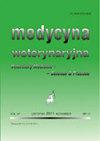口蹄疫和小反刍兽疫——野生动物在流行病学和疾病控制中的作用
IF 0.4
4区 农林科学
Q4 VETERINARY SCIENCES
Medycyna Weterynaryjna-Veterinary Medicine-Science and Practice
Pub Date : 2023-01-01
DOI:10.21521/mw.6737
引用次数: 1
摘要
口蹄疫(FMD)和小反刍兽疫(PPR)是一种具有高度传染性和经济破坏性的疾病,目前在非洲和亚洲大陆流行。本文的目的是介绍野生动物在这两种疾病的流行病学中的作用。有100多种野生、野生、实验室或家养动物自然或实验感染了口蹄疫或小反刍兽疫病毒。几种非洲野生反刍动物的实验性感染可导致临床口蹄疫。非洲水牛是撒哈拉以南非洲最著名的口蹄疫野生宿主宿主。发现北美骡鹿易感染FMDV,死亡率显著。其他野生反刍动物,如黑斑羚,也有助于FMDV的维持。在欧洲,几种鹿和欧亚野猪易感染口蹄疫病毒。据报道,PPRV已经感染了一些野生动物,如非洲水牛、赛加羚羊、土羚、大羚羊、努比亚野山羊和一些其他有蹄类动物。野生动物在口蹄疫和小反刍兽疫流行病学中的作用可能涉及野生动物作为两种疾病的指示者、受害者、桥梁宿主或维持宿主。此外,它们偶尔也是疾病爆发的受害者,它们通常作为桥梁或维护宿主与疾病管理有关。在一个不断变化的世界中,野生动物应该成为未来综合监测和疾病控制战略的关键组成部分。然而,必须指出的是,当口蹄疫和小反刍兽疫在牲畜中流行时,控制野生动物口蹄疫和小反刍兽疫的努力可能不会成功,并可能对野生动物、人类生计和家畜造成更大的危害。本文章由计算机程序翻译,如有差异,请以英文原文为准。
Foot-and mouth disease and peste des petits ruminants – the role of wildlife in the epidemiology and control of diseases
Foot-and mouth disease (FMD) and peste des petits ruminants (PPR) are highly contagious and an economically devastating diseases, currently endemic to the African and Asian continents. The aim of this paper was to present the role of wildlife in the epidemiology of both diseases. There are more than 100 species of wild, feral, laboratory, or domesticated animals that have been infected naturally or experimentally with FMD or PPR viruses. Experimental infections of several African wild ruminants can result in clinical FMD. African buffalo represents the best known FMD wild host reservoir in Sub-Saharan Africa. North American mule deer were found susceptible to FMDV infection with significant mortality. Other wild ruminants such as impala can also contribute to FMDV maintenance. In Europe several deer species and the Eurasian wild boar are susceptible to FMDV. PPRV has been reported to have infected some wildlife, such as African buffalo, saiga antelope, dorcas gazelles, gemsbok, Nubian ibex and some other ungulate species. The role of wildlife in FMD and PPR epidemiology may concern wildlife as indicators, victims, bridge hosts or maintenance hosts for both diseases. In addition, they are occasionally victims of disease outbreaks, and they are often relevant for disease management as either bridge or maintenance hosts. Wildlife deserves to become a key component of future integrated surveillance and disease control strategies in an ever-changing world. However, it must be stated that efforts to control FMD and PPR in wildlife may not be successful when the diseases are endemic in livestock and may cause more harm to wildlife, human livelihoods, and domestic animals.
求助全文
通过发布文献求助,成功后即可免费获取论文全文。
去求助
来源期刊

Medycyna Weterynaryjna-Veterinary Medicine-Science and Practice
VETERINARY SCIENCES-
CiteScore
0.80
自引率
0.00%
发文量
73
审稿时长
4-8 weeks
期刊介绍:
"Medycyna Weterynaryjna" publishes various types of articles which are grouped in the following editorial categories: reviews, original studies, scientific and professional problems, the history of veterinary medicine, posthumous memoirs, as well as chronicles that briefly relate scientific advances and developments in the veterinary profession and medicine. The most important are the first two categories, which are published with short summaries in English. Moreover, from 2001 the editors of "Medycyna Weterynaryjna", bearing in mind market demands, has also started publishing entire works in English. Since 2008 the periodical has appeared in an electronic version. The following are available in this version: summaries of studies published from 1999 to 2005, full versions of all the studies published in the years 2006-2011 (in pdf files), and full versions of the English studies published in the current year (pdf). Only summaries of the remaining studies from the current year are available. In accordance with the principles accepted by the editors, the full versions of these texts will not be made available until next year.
All articles are evaluated twice by leading Polish scientists and professionals before they are considered for publication. For years now "Medycyna Weterynaryjna" has maintained a high standard thanks to this system. The review articles are actually succinct monographs dealing with specific scientific and professional problems that are based on the most recent findings. Original works have a particular value, since they present research carried out in Polish and international scientific centers.
 求助内容:
求助内容: 应助结果提醒方式:
应助结果提醒方式:


